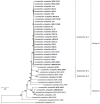Development of a High-Resolution Single-Nucleotide Polymorphism Strain-Typing Assay Using Whole Genome-Based Analyses for the Lactobacillus acidophilus Probiotic Strain
- PMID: 32967209
- PMCID: PMC7564606
- DOI: 10.3390/microorganisms8091445
Development of a High-Resolution Single-Nucleotide Polymorphism Strain-Typing Assay Using Whole Genome-Based Analyses for the Lactobacillus acidophilus Probiotic Strain
Abstract
Lactobacillus acidophilus is one of the most commonly used industrial products worldwide. Since its probiotic efficacy is strain-specific, the identification of probiotics at both the species and strain levels is necessary. However, neither phenotypic nor conventional genotypic methods have enabled the effective differentiation of L. acidophilus strains. In this study, a whole-genome sequence-based analysis was carried out to establish high-resolution strain typing of 41 L. acidophilus strains (including commercial isolates and reference strains) using the cano-wgMLST_BacCompare analytics platform; consequently, a strain-specific discrimination method for the probiotic strain LA1063 was developed. Using a core-genome multilocus sequence-typing (cgMLST) scheme based on 1390 highly conserved genes, 41 strains could be assigned to 34 sequence types. Subsequently, we screened a set of 92 loci with a discriminatory power equal to that of the 1390 loci cgMLST scheme. A strain-specific polymerase chain reaction combined with a multiplex minisequencing method was developed based on four (phoU, secY, tilS, and uvrA_1) out of 21 loci, which could be discriminated between LA1063 and other L. acidophilus strains using the cgMLST data. We confirmed that the strain-specific single-nucleotide polymorphisms method could be used to quickly and accurately identify the L. acidophilus probiotic strain LA1063 in commercial products.
Keywords: Lactobacillus acidophilus; Strain-Specific Identification; core genome MLST; monophyletic bacterium; whole genome sequences.
Conflict of interest statement
The authors declare no conflict of interest.
Figures





References
-
- Fujisawa T., Benno Y., Yaeshima T., Mitsuoka T. Taxonomic study of the Lactobacillus acidophilus group, with recognition of Lactobacillus gallinarum sp. nov. and Lactobacillus johnsonii sp. nov. and synonymy of Lactobacillus acidophilus group A3 (Johnson et al. 1980) with the type strain of Lactobacillus amylovorus (Nakamura 1981) Int. J. Syst. Bacteriol. 1992;42:487–491. - PubMed
-
- Román-Méndez C., Badet C., Yáñez A., Dominguez M.A., Giono S., Richard B., Nancy J., Dorignac G. Identification of oral strains of Lactobacillus species isolated from Mexican and French children. J. Dent. Oral Hyg. 2009;1:009–016.
Grants and funding
LinkOut - more resources
Full Text Sources
Molecular Biology Databases

